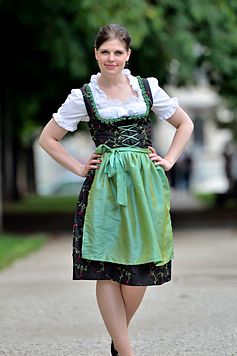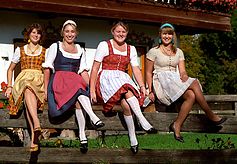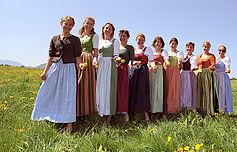- Dirndl
-
A dirndl [ˈdɪʁndl̩] is a type of traditional dress worn in Bavaria, Liechtenstein, Austria, and South Tyrol, based on the historical costume of Alpine peasants. Dresses that are loosely based on the dirndl are known as Landhausmode.
Contents
Description
The dirndl consists of a bodice, blouse, full skirt and apron. While appearing to be simple and plain, a properly made modern dirndl may be quite expensive as it is tailored and sometimes cut from costly hand-printed or silk fabrics. In the South German dialects (Bairisch), Dirndl originally referred to a young woman or a girl, and Dirndlgewand to the dress. Nowadays, Dirndl may equally refer to either a young woman or to the dress.
The winter style dirndl has heavy, warm skirts and aprons made of thick cotton, linen, velvet or wool, and long sleeves. The colors are usually rich and dark. The summer style is lighter and more frivolous, has short sleeves, and is often made of lightweight cotton.
Accessories may include a long apron tied round the waist, a waistcoat or a wool shawl. In many regions, especially the Ausseerland, vibrantly-colored, hand-printed silk scarfs and silk aprons are worn. As far as jewelry is concerned, women often sport necklaces, earrings and brooches made of silver, the antlers of deer or even animals' teeth. For colder weather there are heavy dirndl coats in the same cut as the dresses, with a high neck and front buttons, thick mittens and wool hats.
In the media it is sometimes reported that the placement of the knot on the apron is an indicator of the woman's marital status. When this is so, a knot tied on the woman's left side indicates she is single, a knot tied on the right means she is married, engaged or otherwise "taken", and a knot tied at the back means the woman is widowed. This may not be an old tradition, because women who had been married at that time were expected to have another dress.
History
The dirndl originated as a more hardy form of the costume we have today; the uniform of Austrian servants in the 19th century (Dirndlgewand means "maid's dress"). Simple forms were also worn commonly by working women in plain colours or a simple check. Originally, each village had its own style and crest. The Austrian upper classes adopted the dirndl as high fashion in the 1870s. Today, dirndls vary from simple styles to exquisitely crafted, very expensive models.
Etiquette
The dirndl is mostly worn in Austria and Bavaria. It is used as an everyday dress primarily by older women in rural areas. Other women may wear it at formal occasions (much like a Scotsman wearing a kilt) and during certain traditional events. It is hugely popular also among young women at the time of the Oktoberfest in Munich (and similar festivals in southern Germany, Austria, Brazil, Canada, and the United States), although many young women will only wear dirndl-style dresses (called Landhausmode), which may deviate in numerous ways and are often much cheaper.
In Austria, Bavaria and southern Brazil, the dirndl may often be seen on women working in tourism-related businesses, and sometimes waitresses in traditional-style restaurants or biergartens. It is also seen in these regions on women in the Volksmusik business.
See also
References
- Notes
External links
 Media related to Dirndl at Wikimedia Commons
Media related to Dirndl at Wikimedia Commons
Categories:- Austro-Bavarian words and phrases
- German loanwords
- German clothing
- Austrian clothing
- Skirts
- Dresses
Wikimedia Foundation. 2010.



